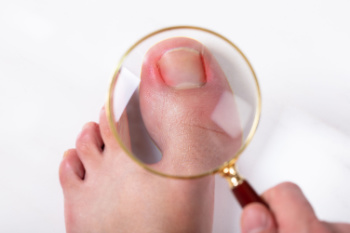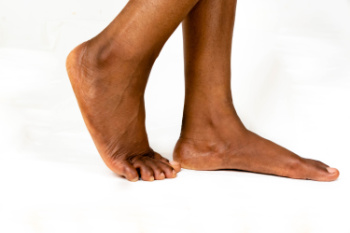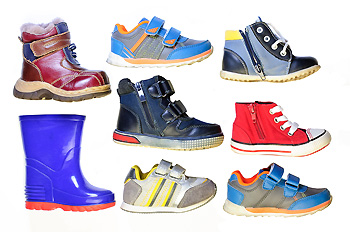Connect With Us
Blog

Ingrown toenails occur when the edge of a toenail grows into the surrounding skin, often due to improper trimming, tight footwear, trauma, or inherited nail shape. They may look red, swollen, or curved into the skin. As inflammation increases, the area can become warm and tender. Many people describe a sharp or throbbing pain when walking or even when light pressure touches the toe. In some cases, drainage or infection can develop. The big toe is the most commonly affected because it endures the greatest pressure inside shoes. A podiatrist can start by examining the toe to determine the severity and confirm whether infection is present. Treatments may include gentle removal of the offending nail edge, relief of trapped pressure, guidance on proper nail care, or a minor procedure to prevent the ingrown side from returning. Early care reduces discomfort and supports faster healing. If you notice persistent pain, redness, or swelling around a toenail, it is suggested that you make an appointment with a podiatrist.
Ingrown toenails can become painful if they are not treated properly. For more information about ingrown toenails, contact David Reynolds, DPM of First Podiatry. Our doctor can provide the care you need to keep you pain-free and on your feet.
Ingrown Toenails
Ingrown toenails occur when a toenail grows sideways into the bed of the nail, causing pain, swelling, and possibly infection.
Causes
- Bacterial infections
- Improper nail cutting such as cutting it too short or not straight across
- Trauma to the toe, such as stubbing, which causes the nail to grow back irregularly
- Ill-fitting shoes that bunch the toes too close together
- Genetic predisposition
Prevention
Because ingrown toenails are not something found outside of shoe-wearing cultures, going barefoot as often as possible will decrease the likeliness of developing ingrown toenails. Wearing proper fitting shoes and using proper cutting techniques will also help decrease your risk of developing ingrown toenails.
Treatment
Ingrown toenails are a very treatable foot condition. In minor cases, soaking the affected area in salt or antibacterial soaps will not only help with the ingrown nail itself, but also help prevent any infections from occurring. In more severe cases, surgery is an option. In either case, speaking to your podiatrist about this condition will help you get a better understanding of specific treatment options that are right for you.
If you have any questions, please feel free to contact our office located in Evansville, IN . We offer the newest diagnostic and treatment technologies for all your foot care needs.

Flat feet occur when the arches of the feet collapse, causing the entire sole to touch the ground. This condition can lead to pain in the feet, ankles, and even the lower legs. Strengthening and stretching exercises are important for helping people with flat feet because they improve the function of the muscles that support the arch. Weak or imbalanced muscles, such as the posterior tibial muscle, can increase stress on the arch and contribute to plantar fasciitis, a painful inflammation of the band of tissue that connects the heel to the toes. Exercises designed to build strength in the foot and ankle help improve alignment, stability, and flexibility, allowing the feet to absorb impact more efficiently. A podiatrist can evaluate foot structure, recommend specific exercises, and suggest supportive footwear or custom orthotics to help manage pain. If you often have foot pain linked to flat feet, it is suggested that you schedule an appointment with a podiatrist for an exam and effective relief tips.
Flatfoot is a condition many people suffer from. If you have flat feet, contact David Reynolds, DPM from First Podiatry. Our doctor will treat your foot and ankle needs.
What Are Flat Feet?
Flatfoot is a condition in which the arch of the foot is depressed and the sole of the foot is almost completely in contact with the ground. About 20-30% of the population generally has flat feet because their arches never formed during growth.
Conditions & Problems:
Having flat feet makes it difficult to run or walk because of the stress placed on the ankles.
Alignment – The general alignment of your legs can be disrupted, because the ankles move inward which can cause major discomfort.
Knees – If you have complications with your knees, flat feet can be a contributor to arthritis in that area.
Symptoms
- Pain around the heel or arch area
- Trouble standing on the tip toe
- Swelling around the inside of the ankle
- Flat look to one or both feet
- Having your shoes feel uneven when worn
Treatment
If you are experiencing pain and stress on the foot you may weaken the posterior tibial tendon, which runs around the inside of the ankle.
If you have any questions, please feel free to contact our office located in Evansville, IN . We offer the newest diagnostic and treatment technologies for all your foot care needs.

Proper footwear plays an essential role in healthy foot development for children. A child’s foot contains 26 bones and 35 joints, supported by soft tissues that are still developing strength and stability. When toddlers first begin walking, many appear flat-footed or may turn their feet inward, which usually improves as the arches and muscles strengthen. Shoes should provide protection without restricting natural movement, allowing the toes to spread and the foot to flex. Properly fitted footwear should include a wide toe box, flexible sole that bends near the front, and a secure heel counter to support alignment. Shoes that lack adequate support or are too tight can interfere with walking, and contribute to ingrown toenails or abnormal gait. A podiatrist can assess the structure and function of a child’s feet, monitor growth, and recommend footwear that reduces the risk of long-term complications. If your child is experiencing foot problems, it is suggested that you schedule an appointment with a podiatrist for an exam and appropriate treatment.
The health of a child’s feet is vital to their overall well-being. If you have any questions regarding foot health, contact David Reynolds, DPM of First Podiatry. Our doctor can provide the care you need to keep you pain-free and on your feet.
Tips for Keeping Children's Feet Healthy
- Make sure their shoes fit properly
- Look for any signs of in-toeing or out-toeing
- Check to see if they have Clubfoot (condition that affects your child’s foot and ankle, twisting the heel and toes inward) which is one of the most common nonmajor birth defects.
- Lightly cover your baby’s feet (Tight covers may keep your baby from moving their feet freely, and could prevent normal development)
- Allow your toddler to go shoeless (Shoes can be restricting for a young child’s foot)
- Cut toenails straight across to avoid ingrown toenails
- Keep your child’s foot clean and dry
- Cover cuts and scrapes. Wash any scratches with soap and water and cover them with a bandage until they’ve healed.
If you have any questions, please feel free to contact our office located in Evansville, IN . We offer the newest diagnostic and treatment technologies for all your foot care needs.

